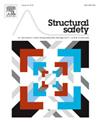Spatial variability identification of carbonation depth in concrete using Bayesian networks
IF 6.3
1区 工程技术
Q1 ENGINEERING, CIVIL
引用次数: 0
Abstract
Accurate prediction of carbonation depth is crucial for evaluating the durability and service life of reinforced concrete structures. Traditional methods for assessing carbonation depth often involve destructive testing, which is both costly and time-consuming, and yields results with limited accuracy, thus restricting their practical applicability. To address these shortcomings, this research introduces a novel two-step procedure that leverages inspection data on concrete porosity and saturation degree to estimate carbonation depth. By integrating Bayesian networks and considering the influence of spatial variability, the proposed methodology aims to enhance prediction accuracy compared to existing techniques. The study comprehensively investigates the impact of various factors, including the use of individual or combined inspection data, spatial dependence, and inspection distance, on prediction performance. The findings demonstrate the effectiveness of the proposed approach in capturing complex interactions between concrete properties, carbonation depth, and spatial variability. This research contributes to the advancement of non-destructive evaluation methods for concrete structures and provides valuable insights for optimizing inspection strategies.
利用贝叶斯网络识别混凝土碳化深度的空间变异性
准确预测碳化深度是评价钢筋混凝土结构耐久性和使用寿命的关键。评估碳酸化深度的传统方法通常涉及破坏性测试,既昂贵又耗时,而且结果精度有限,从而限制了其实际适用性。为了解决这些缺点,本研究引入了一种新的两步程序,该程序利用混凝土孔隙度和饱和度的检测数据来估计碳化深度。通过整合贝叶斯网络并考虑空间变异性的影响,与现有技术相比,该方法旨在提高预测精度。该研究全面考察了各种因素对预测性能的影响,包括单个或组合检测数据的使用、空间依赖性和检测距离。研究结果表明,所提出的方法在捕获混凝土性能、碳化深度和空间变异性之间复杂的相互作用方面是有效的。本研究对混凝土结构无损评价方法的发展具有重要意义,并为优化检测策略提供了有价值的见解。
本文章由计算机程序翻译,如有差异,请以英文原文为准。
求助全文
约1分钟内获得全文
求助全文
来源期刊

Structural Safety
工程技术-工程:土木
CiteScore
11.30
自引率
8.60%
发文量
67
审稿时长
53 days
期刊介绍:
Structural Safety is an international journal devoted to integrated risk assessment for a wide range of constructed facilities such as buildings, bridges, earth structures, offshore facilities, dams, lifelines and nuclear structural systems. Its purpose is to foster communication about risk and reliability among technical disciplines involved in design and construction, and to enhance the use of risk management in the constructed environment
 求助内容:
求助内容: 应助结果提醒方式:
应助结果提醒方式:


